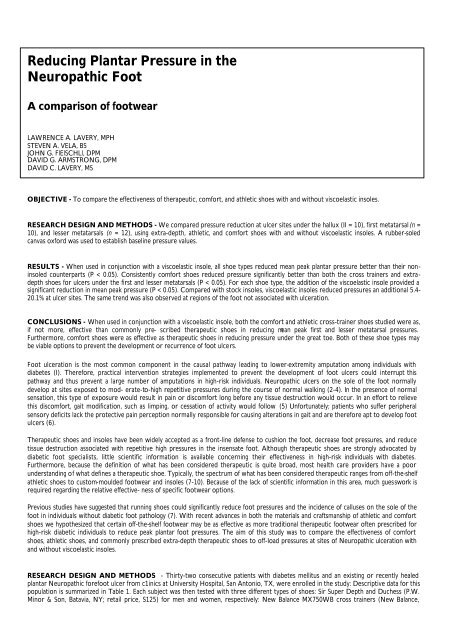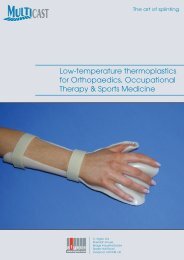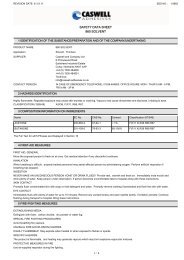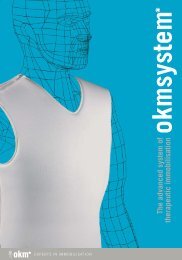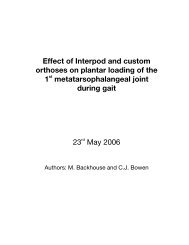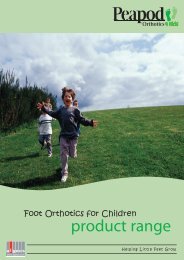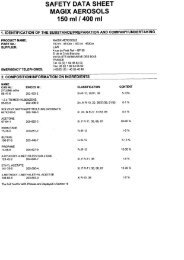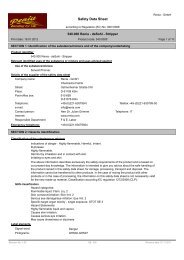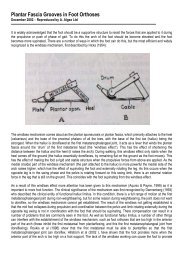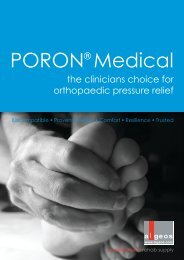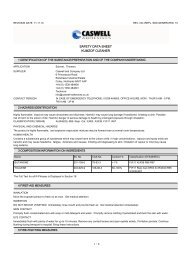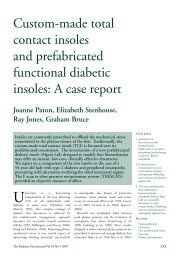Reducing Plantar Pressure in the Neuropathic Foot - ResearchGate
Reducing Plantar Pressure in the Neuropathic Foot - ResearchGate
Reducing Plantar Pressure in the Neuropathic Foot - ResearchGate
Create successful ePaper yourself
Turn your PDF publications into a flip-book with our unique Google optimized e-Paper software.
<strong>Reduc<strong>in</strong>g</strong> <strong>Plantar</strong> <strong>Pressure</strong> <strong>in</strong> <strong>the</strong><strong>Neuropathic</strong> <strong>Foot</strong>A comparison of footwearLAWRENCE A. LAVERY, MPHSTEVEN A. VELA, BSJOHN G. FlElSCHLl, DPMDAVID G. ARMSTRONG, DPMDAVID C. LAVERY, MSOBJECTIVE - To compare <strong>the</strong> effectiveness of <strong>the</strong>rapeutic, comfort, and athletic shoes with and without viscoelastic <strong>in</strong>soles.RESEARCH DESIGN AND METHODS - We compared pressure reduction at ulcer sites under <strong>the</strong> hallux (II = 10), first metatarsal (n =10), and lesser metatarsals (n = 12), us<strong>in</strong>g extra-depth, athletic, and comfort shoes with and without viscoelastic <strong>in</strong>soles. A rubber-soledcanvas oxford was used to establish basel<strong>in</strong>e pressure values.RESULTS - When used <strong>in</strong> conjunction with a viscoelastic <strong>in</strong>sole, all shoe types reduced mean peak plantar pressure better than <strong>the</strong>ir non<strong>in</strong>soledcounterparts (P < 0.05). Consistently comfort shoes reduced pressure significantly better than both <strong>the</strong> cross tra<strong>in</strong>ers and extradepthshoes for ulcers under <strong>the</strong> first and lesser metatarsals (P < 0.05). For each shoe type, <strong>the</strong> addition of <strong>the</strong> viscoelastic <strong>in</strong>sole provided asignificant reduction <strong>in</strong> mean peak pressure (P < 0.05). Compared with stock <strong>in</strong>soles, viscoelastic <strong>in</strong>soles reduced pressures an additional 5.4-20.1% at ulcer sites. The same trend was also observed at regions of <strong>the</strong> foot not associated with ulceration.CONCLUSIONS - When used <strong>in</strong> conjunction with a viscoelastic <strong>in</strong>sole, both <strong>the</strong> comfort and athletic cross-tra<strong>in</strong>er shoes studied were as,if not more, effective than commonly pre- scribed <strong>the</strong>rapeutic shoes <strong>in</strong> reduc<strong>in</strong>g mean peak first and lesser metatarsal pressures.Fur<strong>the</strong>rmore, comfort shoes were as effective as <strong>the</strong>rapeutic shoes <strong>in</strong> reduc<strong>in</strong>g pressure under <strong>the</strong> great toe. Both of <strong>the</strong>se shoe types maybe viable options to prevent <strong>the</strong> development or recurrence of foot ulcers.<strong>Foot</strong> ulceration is <strong>the</strong> most common component <strong>in</strong> <strong>the</strong> causal pathway lead<strong>in</strong>g to lower-extremity amputation among <strong>in</strong>dividuals withdiabetes (I). Therefore, practical <strong>in</strong>tervention strategies implemented to prevent <strong>the</strong> development of foot ulcers could <strong>in</strong>terrupt thispathway and thus prevent a large number of amputations <strong>in</strong> high-risk <strong>in</strong>dividuals. <strong>Neuropathic</strong> ulcers on <strong>the</strong> sole of <strong>the</strong> foot normallydevelop at sites exposed to mod- erate-to-high repetitive pressures dur<strong>in</strong>g <strong>the</strong> course of normal walk<strong>in</strong>g (2-4). In <strong>the</strong> presence of normalsensation, this type of exposure would result <strong>in</strong> pa<strong>in</strong> or discomfort long before any tissue destruction would occur. In an effort to relievethis discomfort, gait modification, such as limp<strong>in</strong>g, or cessation of activity would follow (5) Unfortunately; patients who suffer peripheralsensory deficits lack <strong>the</strong> protective pa<strong>in</strong> perception normally responsible for caus<strong>in</strong>g alterations <strong>in</strong> gait and are <strong>the</strong>refore apt to develop footulcers (6).Therapeutic shoes and <strong>in</strong>soles have been widely accepted as a front-l<strong>in</strong>e defense to cushion <strong>the</strong> foot, decrease foot pressures, and reducetissue destruction associated with repetitive high pressures <strong>in</strong> <strong>the</strong> <strong>in</strong>sensate foot. Although <strong>the</strong>rapeutic shoes are strongly advocated bydiabetic foot specialists, little scientific <strong>in</strong>formation is available concern<strong>in</strong>g <strong>the</strong>ir effectiveness <strong>in</strong> high-risk <strong>in</strong>dividuals with diabetes.Fur<strong>the</strong>rmore, because <strong>the</strong> def<strong>in</strong>ition of what has been considered <strong>the</strong>rapeutic is quite broad, most health care providers have a poorunderstand<strong>in</strong>g of what def<strong>in</strong>es a <strong>the</strong>rapeutic shoe. Typically, <strong>the</strong> spectrum of what has been considered <strong>the</strong>rapeutic ranges from off-<strong>the</strong>-shelfathletic shoes to custom-moulded footwear and <strong>in</strong>soles (7-10). Because of <strong>the</strong> lack of scientific <strong>in</strong>formation <strong>in</strong> this area, much guesswork isrequired regard<strong>in</strong>g <strong>the</strong> relative effective- ness of specific footwear options.Previous studies have suggested that runn<strong>in</strong>g shoes could significantly reduce foot pressures and <strong>the</strong> <strong>in</strong>cidence of calluses on <strong>the</strong> sole of <strong>the</strong>foot <strong>in</strong> <strong>in</strong>dividuals without diabetic foot pathology (7). With recent advances <strong>in</strong> both <strong>the</strong> materials and craftsmanship of athletic and comfortshoes we hypo<strong>the</strong>sized that certa<strong>in</strong> off-<strong>the</strong>-shelf footwear may be as effective as more traditional <strong>the</strong>rapeutic footwear often prescribed forhigh-risk diabetic <strong>in</strong>dividuals to reduce peak plantar foot pressures. The aim of this study was to compare <strong>the</strong> effectiveness of comfortshoes, athletic shoes, and commonly prescribed extra-depth <strong>the</strong>rapeutic shoes to off-Ioad pressures at sites of <strong>Neuropathic</strong> ulceration withand without viscoelastic <strong>in</strong>soles.RESEARCH DESIGN AND METHODS - Thirty-two consecutive patients with diabetes mellitus and an exist<strong>in</strong>g or recently healedplantar <strong>Neuropathic</strong> forefoot ulcer from c1<strong>in</strong>ics at University Hospital, San Antonio, TX, were enrolled <strong>in</strong> <strong>the</strong> study: Descriptive data for thispopulation is summarized <strong>in</strong> Table 1. Each subject was <strong>the</strong>n tested with three different types of shoes: Sir Super Depth and Duchess (P.W.M<strong>in</strong>or & Son, Batavia, NY; retail price, S125) for men and women, respectively: New Balance MX750WB cross tra<strong>in</strong>ers (New Balance,
Boston. MA; retail price $65): and SAS Timeout and Freetime comfort shoes (SAS Shoemakers, San Antonio, TX; retail price, $65) for menand women, respectively (Figs. 1-3). These shoe types were chosen because <strong>the</strong> manufacturer's <strong>in</strong>serts could be removed and anaccommodative <strong>in</strong>sole could be <strong>in</strong>serted <strong>in</strong> <strong>the</strong>ir place and because <strong>the</strong>y are often used as an alternative to traditional <strong>the</strong>rapeutic extradepthshoes (7,11). In addition to be<strong>in</strong>g tested with <strong>the</strong> manufacturer's <strong>in</strong>sole, each shoe was evaluated with an unmodified 4mmplastazote/urethane <strong>in</strong>sole (AliMed, Dedham, MA) (Fig. 4). We also used a th<strong>in</strong> rubber-soled canvas oxford sneaker to establish basel<strong>in</strong>epressures that might be observed <strong>in</strong> <strong>in</strong>dividuals without <strong>the</strong>rapeutic footwear (Fig, 5).D}i1amic plantar foot pressures were evaluated us<strong>in</strong>g <strong>the</strong> Novel Pedar <strong>in</strong>-shoe pressure measurement system (Novel. M<strong>in</strong>neapolis, MN).Data were collected at 50 Hz us<strong>in</strong>g 2mm thick capacitance <strong>in</strong>soles with 99 sensors per <strong>in</strong>sole and a spatial sensor resolution dependent on<strong>in</strong>sole size (average, I sensor/cm2). The th<strong>in</strong> pressure-measur<strong>in</strong>g <strong>in</strong>sole has a l<strong>in</strong>ear response to applied loads rang<strong>in</strong>g from 0 to 50 N/cm²with m<strong>in</strong>imal error and has not been shown to <strong>in</strong>terfere with normal gait characteristics (12). A description of <strong>the</strong> Novel Pedar system andcomponents have been previously reported (12,13).Four gait trials were performed for each of <strong>the</strong> six treatment methods with <strong>the</strong> Novel Pedar <strong>in</strong>sole placed <strong>in</strong> direct contact with <strong>the</strong> sole ofeach patient's foot, Treatments were evaluated <strong>in</strong> a random order. For each treatment, subjects were allowed to practice walk<strong>in</strong>g until <strong>the</strong>yfelt comfortable, so <strong>the</strong>ir gait pattern would be as consistent as possible dur<strong>in</strong>g each trial. After this "break-<strong>in</strong>" period, subjects were<strong>in</strong>structed to walk at a self-selected pace. To elim<strong>in</strong>ate <strong>the</strong> highly variable steps associated with term<strong>in</strong>ation and <strong>in</strong>itiation of gait, only midgaitsteps were evaluated from each trial. From <strong>the</strong>se trials, we measured pressure distribution from a total of 32 steps for each patient foreach treatment.Table 1 Patient CharacteristicsAge (years)Duration of diabetes (years)Bio<strong>the</strong>siometer (V)BMI (kg/m2)Diabetes (type 1/2)Sex (M/F)Ulcer siteFirst metatarsalSecond through fifth metatarsalsGreat toe50.5 ± 9.5 (29-6j)13.6 ± 9.9 (1-37)41.2 ± 13.0 (8-50)31.2 ± 5.0 (22-41)2/3021/11101210We used SPSS version 7.5 to perform <strong>the</strong> statistical analysis of this data (SPSS, Chicago, IL). For <strong>the</strong> purposes of analysis, pressures for ulcerslocated under <strong>the</strong> first metatarsal head (n = 10), second through fifth metatarsal heads (n = 12), and great toe (n = 10) were evaluatedseparately. We focused comparisons of treatments on <strong>the</strong> site of ulceration because this was thought to be <strong>the</strong> most important site cl<strong>in</strong>ically;<strong>the</strong> site of <strong>the</strong> highest pressure (l1,14), and <strong>the</strong> most likely site of re-ulceration (6,15). Therefore, to compare <strong>the</strong> effect of different shoetypes with and without plastazote/urethane <strong>in</strong>soles, we used a repeated measures design <strong>in</strong> which 32 replications were nested with<strong>in</strong> eachtreatment for each patient analysis of <strong>the</strong> data was carried out us<strong>in</strong>g univariate and multivariate analysis of variance procedures. Tukey’smultiple range test was used to compare mean differences simultaneously between shoe types both with and without viscoelastic <strong>in</strong>soles. We<strong>the</strong>n used a paired t test to perform a with<strong>in</strong>-group comparison of peak foot pressures with <strong>the</strong> manufacturers stock <strong>in</strong>soles and viscoelastic<strong>in</strong>soles for each shoe type. For all analyses, we used an I of 0.05.RESULTS -Table 2 demonstrates mean peak pressures and <strong>the</strong> percentage change from basel<strong>in</strong>e measurements with canvas oxford shoesfor each of <strong>the</strong> shoe types, evaluated with and without a viscoelastic (plastazote/urethane) <strong>in</strong>sole. When <strong>in</strong>itially compar<strong>in</strong>g peak pressurereduction between shoe types, we used <strong>the</strong> manufacturers stock <strong>in</strong>sole provided with each pair of shoes. When this treatment group wasevaluated, <strong>the</strong>re was a consistent pattern of performance for ulcers located under <strong>the</strong> first and lesser metatarsals. Comfort shoes providedsignificantly lower pressures than both <strong>the</strong> cross tra<strong>in</strong>ers and extra-depth shoes (P < 0.05).For great-toe ulcers, extra-depth shoes and comfort shoes functioned equally well, and both reduced pressures significantly more than crosstra<strong>in</strong>ers (P < 0.05). In fact, <strong>the</strong> only <strong>in</strong>stance where foot pressures were actually <strong>in</strong>creased (compared with basel<strong>in</strong>e values) was <strong>in</strong> patientswith great-toe ulcers treated with off-<strong>the</strong>-shelf cross tra<strong>in</strong>ers. Peak foot pressure was <strong>in</strong>creased 12.2% us<strong>in</strong>g this treatment. For all o<strong>the</strong>rsites, <strong>the</strong>re was a significant reduction <strong>in</strong> peak foot pressures.Then we substituted <strong>the</strong> manufacturers stock <strong>in</strong>sole with an unmodified plastazote/urethane <strong>in</strong>sole. When this comb<strong>in</strong>ation was evaluated,<strong>the</strong> comfort shoes, cross tra<strong>in</strong>ers, and extra-depth shoes were equivalent <strong>in</strong> <strong>the</strong>ir ability to reduce plantar foot pressures for ulcers under<strong>the</strong> first and lesser metatarsals (P < 0.05). For great-toe ulcers, comfort shoes and extra-depth shoes provided similar pressure reduction,and both reduced pressure significantly more than cross tra<strong>in</strong>ers (P < 0.05). At regions of <strong>the</strong> foot not associated with ulceration, <strong>the</strong>re wasa significant decrease <strong>in</strong> pressure, compared with basel<strong>in</strong>e measurements with rubber-soled canvas oxfords (P < 0.05).In <strong>the</strong> third pan of <strong>the</strong> analysis, we compared pressure measurements with manufacturer stock <strong>in</strong>soles and viscoelastic <strong>in</strong>soles. For each shoetype, <strong>the</strong> addition of <strong>the</strong> viscoelastic <strong>in</strong>sole provided a significant reduction <strong>in</strong> mean peak pressure (P < 0.05). Compared with stock <strong>in</strong>soles.
Therapeutic <strong>in</strong>soles reduced pressures an additional 5.4-20.1% at ulcer sites. The same trend was also observed at regions of <strong>the</strong> foot notassociated with an ulceration (Table 2).CONCLUSIONS - Many studies have l<strong>in</strong>ked high plantar pressures to sites of ulceration <strong>in</strong> diabetic <strong>in</strong>dividuals with neuropathy (14,16).Brand (3) identified neuropathy; abnormal pressures, and repetitive trauma as important causative factors <strong>in</strong> <strong>the</strong> development of foot ulcers.He <strong>the</strong>orized that repetitive moderate pressures applied over an extended period of time caused a local <strong>in</strong>flammatory response, followed byfocal tissue ischemia, tissue destruction, and f<strong>in</strong>ally ulceration. A logical treatment approach based on <strong>the</strong>se observations is that <strong>in</strong>terrupt<strong>in</strong>gthis pathway would decrease <strong>the</strong> likelihood that an <strong>in</strong>sensate <strong>in</strong>dividual would develop an ulcer. S<strong>in</strong>ce efforts to improve peripheral sensationand decrease patient activity have been typically unsuccessful (6), us<strong>in</strong>g shoes and <strong>in</strong>soles to reduce foot pressures seems to be one of <strong>the</strong>least expensive and most practical means to prevent <strong>the</strong> development or recurrence of <strong>Neuropathic</strong> foot wounds (11,17).Table 2 – Effectiveness of shoes with and without <strong>in</strong>soles to reduce pressures at ulcer sitesPatients with first successMetatarsal ulcersShoe type Insole Ulcer site SecondthroughfifthmetatarsalsCanvasoxfords(basel<strong>in</strong>e)Patients with secondMetatarsal ulcersGreat toe Ulcer site FirstmetatarsalPatients with great-toe ulcersGreat toe Ulcer site FirstmetatarsalSecondthroughfifthmetatarsalNo 49.7±16.9 39.6±10.9 22.1±13.7 45.2±11.8 38.5±13.8 20.5±10.7 21.1±11.0 25.2±8.7 36.1±11.4P.W. M<strong>in</strong>or<strong>the</strong>rapeuticshoesYes 28.4±10.242.9No 35.5±16.228.622.3±6.143.727.6±9.230.315.7±7.329.019.0±9.114.223.8±4.547.327.7±7.138.922.2±5.442.325.5±7.933.816.4±7.320.018.1±8.411.717.2±6.518.519.2±8.29.022.7±7.09.923.8±6.35.621.8±5.239.624.3±5.432.7NewBalancecrossYes 28.5±10.542.7tra<strong>in</strong>ers No 32.4±12.534.823.4±6.340.926.0±6.534.316.9±6.823.718.0±6.718.624.6±4.945.626.5±5.141.420.8±4.746.023.0±4.940.317.9±8.812.718.2±8.411.220.4±8.23.323.7±10.9-12.320.3±6.319.421.5±5.414.722.6±4.737.424.5±5.632.1SAS comfortshoesYes 27.4±10.344.924.0±7.639.417.8±6.919.523.3±4.048.522.1±4.642.614.8±7.127.817.6±9.016.622.7±7.89.920.1±4.844.3No 29.2±12.941.224.6±6.637.918.5±9.216.324.7±5.345.421.6±4.143.916.1±7.121.519.8±11.06.224.8±6.613.522.2±5.438.5On of <strong>the</strong> goals of shoe <strong>the</strong>rapy for high-risk <strong>in</strong>dividuals with diabetes is to reduce potentially dangerous pressures to safe levels (8), Boultonet al. (18) evaluated barefoot pressures <strong>in</strong> <strong>Neuropathic</strong> and non- <strong>Neuropathic</strong> diabetic patients and found that pressures were >110 Ncm²for every subject with a foot ulcer, suggest<strong>in</strong>g a threshold pressure below which <strong>in</strong>dividuals would not ulcerate, Only 31% of diabetic subjectswithout a history of ulceration demonstrated abnormal peak foot pressures based on criteria of Boulton et al. (18) It is not clear if athreshold pressure level exists s<strong>in</strong>ce o<strong>the</strong>r reports have Identified lower foot peak pressures at sites of <strong>Neuropathic</strong> ulceration ( 14) thanthose identified by Boulton et al (14.18) In fact, pressure values for <strong>the</strong> patient population <strong>in</strong> this study were substantially lower than thosepreviously reported. Ulceration m <strong>the</strong> <strong>in</strong>sensate foot is probably a function of both <strong>the</strong> magnitude of pressure and <strong>the</strong> frequency of exposure(i.e., <strong>the</strong> number of steps an <strong>in</strong>dividual takes every day) (2). Therefore, a reduction of plantar pressures below an <strong>in</strong>dividual’s pathologicallevel may help to prevent <strong>the</strong> development of <strong>Neuropathic</strong> foot ulcers, even when patients ma<strong>in</strong>ta<strong>in</strong> <strong>the</strong>ir normal level of activity:The results of this study suggest that <strong>the</strong>re were significant differences <strong>in</strong> pressure reduction based on shoe type, anatomic location of ulcer,and use of <strong>the</strong>rapeutic <strong>in</strong>soles. Both <strong>the</strong> comfort and athletic shoes evaluated <strong>in</strong> this study appear to be viable options to traditionalunmodified extra-depth shoes. The comfort and athletic shoes were often equivalent to traditional extra-depth <strong>the</strong>rapeutic shoes <strong>in</strong> reduc<strong>in</strong>gpeak plantar pressures. This proved to be <strong>the</strong> case for ulcers located under <strong>the</strong> metatarsal heads. However, for great-toe ulcers, athleticshoes failed to decrease pressures, as well as <strong>the</strong> o<strong>the</strong>r shoes evaluated. Fur<strong>the</strong>rmore, when <strong>the</strong> manufacturers stock Insoles weresubstituted with off-<strong>the</strong>-shelf plastazote/urethane <strong>in</strong>soles, a fur<strong>the</strong>r reduction <strong>in</strong> peak plantar pressure was realized. Although, not <strong>the</strong> focusof <strong>the</strong> study it is <strong>in</strong>terest<strong>in</strong>g to note that pressures were systematically decreased for ulcer and non-ulcer areas with and without <strong>in</strong>soles,except when cross tra<strong>in</strong>ers were used by patients with ulcers under <strong>the</strong> great toe.Unfortunately, <strong>the</strong>re are only a handful of cl<strong>in</strong>ical studies that describe or compare <strong>the</strong> effectiveness of <strong>the</strong>rapeutic shoes and <strong>in</strong>soles. One of<strong>the</strong> pr<strong>in</strong>cipal drawbacks of <strong>the</strong> current literature is that specifications regard<strong>in</strong>g <strong>the</strong> composition of <strong>the</strong>rapeutic shoes and <strong>in</strong>soles are illdef<strong>in</strong>ed. Cl<strong>in</strong>ical studies suggest that <strong>the</strong> development of new ulcers <strong>in</strong> high-risk diabetic <strong>in</strong>dividuals can be significantly decreased with<strong>the</strong>rapeutic footwear (9.19). In our study conventional shoes, both with and without special <strong>in</strong>soles, were as effective as traditional extradepth<strong>the</strong>rapeutic shoes <strong>in</strong> decreas<strong>in</strong>g foot pressures. However, it is still unclear if alternative footwear, such as comfort and athletic shoes,can be as effective as traditional <strong>the</strong>rapeutic shoes <strong>in</strong> a cl<strong>in</strong>ical sett<strong>in</strong>g.
Although <strong>the</strong>re was a significant reduction <strong>in</strong> pressures at all ulcer sites, <strong>the</strong>re was considerable variation <strong>in</strong> both basel<strong>in</strong>e values and <strong>the</strong>reduction <strong>in</strong> pressures for great-toe ulcers, compared with ulcers under <strong>the</strong> metatarsal heads. In-shoe base-l<strong>in</strong>e peak pressures for ulcersunder <strong>the</strong> metatarsal heads were more than twice as high as those Identified <strong>in</strong> patients with great-toe ulcers. In addition, pressurereduction was 3.2-18.5% for great toe ulcers treated with <strong>in</strong>soles and shoes, compared with a pressure reduction of 42.6 - 48.4% for ulcersunder <strong>the</strong> first metatarsal and lesser metatarsals (Table 2). These results are similar to <strong>the</strong> observations reported by Perry et aI. (11), which<strong>in</strong>dicate that <strong>the</strong> greatest reduction <strong>in</strong> foot pressures was consistently at <strong>the</strong> site of <strong>the</strong> highest barefoot pressure (11). We have been unableto identify previous studies report<strong>in</strong>g that pressures for great-toe ulcers are significantly lower than those under <strong>the</strong> ball of <strong>the</strong> foot. Thismay be because of <strong>the</strong> fact that few studies have stratified outcomes by ulcer location, and many pressure studies performed <strong>in</strong> <strong>the</strong>laboratory use healthy volunteers or diabetic patients without ulcers.The differences we observed are probably due to <strong>the</strong> unique biomechanical pathologies affect<strong>in</strong>g each site (20,21). It can be <strong>in</strong>ferred from <strong>the</strong>results of this study that <strong>the</strong> location of <strong>the</strong> ulcer may dictate <strong>the</strong> style and type of shoe that physicians prescribe. Certa<strong>in</strong>ly, commonmodifications to shoes such as rigid shanks and rocker soles need to be evaluated <strong>in</strong> laboratory and cl<strong>in</strong>ical sett<strong>in</strong>gs to evaluate <strong>the</strong> impact ofulcer location on shoe and <strong>in</strong>sole selection.PAPER SUPPLIED COURTSEY OF ALGEO’SFOR MORE PAPERS LIKE THIS ONE VISIT US ONTHE WEB AT WWW.ALGEOS.COM


